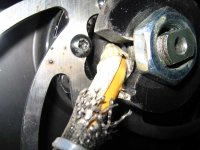binlagin
100 W
The main battery lead is currently set to 50A and the phase to 65A.... yea.. quite a bit lower then it could be  .
.
To be honest.. I'm quite a noob when it comes to this electrical stuff.
I pop'd the FET running at 65A main leads 125A phase with a 30s configuration. I happened under a 75% throttle application up a slight hill from a dead stop. I had previously over heated the controller... I think this might have contributed to the fact it pop'd.
I'll be slowly increasing the phase amps as I get more comfortable that my replaced FETs are good!
To be honest.. I'm quite a noob when it comes to this electrical stuff.
I pop'd the FET running at 65A main leads 125A phase with a 30s configuration. I happened under a 75% throttle application up a slight hill from a dead stop. I had previously over heated the controller... I think this might have contributed to the fact it pop'd.
I'll be slowly increasing the phase amps as I get more comfortable that my replaced FETs are good!





